The DirectX 12 Performance Preview: AMD, NVIDIA, & Star Swarm
by Ryan Smith on February 6, 2015 2:00 PM EST- Posted in
- GPUs
- AMD
- Microsoft
- NVIDIA
- DirectX 12
CPU Scaling
Diving into our look at DirectX 12, let’s start with what is going to be the most critical component for a benchmark like Star Swarm, the CPU scaling.
Because Star Swarm is designed to exploit the threading inefficiencies of DirectX 11, the biggest gains from switching to DirectX 12 on Star Swarm come from removing the CPU bottleneck. Under DirectX 11 the bulk of Star Swarm’s batch submission work happens under a single thread, and as a result the benchmark is effectively bottlenecked by single-threaded performance, unable to scale out with multiple CPU cores. This is one of the issues DirectX 12 sets out to resolve, with the low-level API allowing Oxide to more directly control how work is submitted, and as such better balance it over multiple CPU cores.
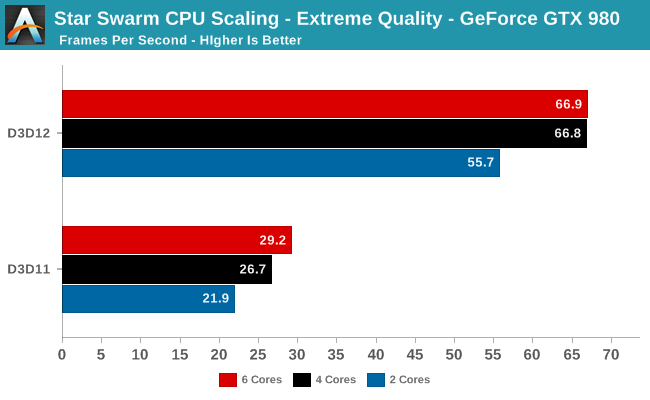
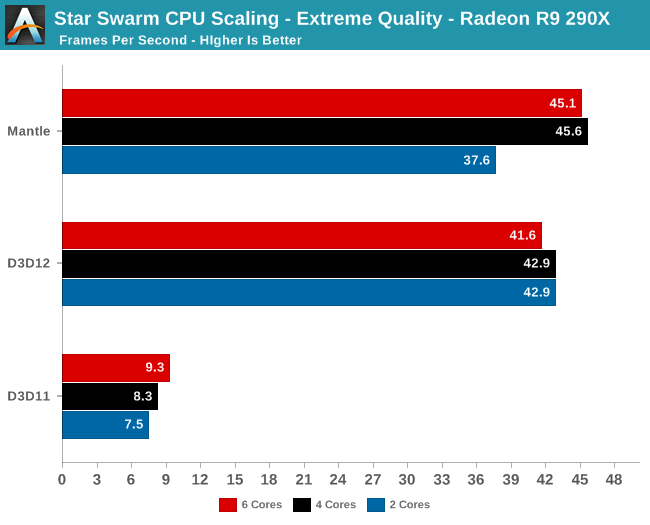
Starting with a look at CPU scaling on our fastest cards, what we find is that besides the absurd performance difference between DirectX 11 and DirectX 12, performance scales roughly as we’d expect among our CPU configurations. Star Swarm's DirectX 11 path, being single-threaded bound, scales very slightly with clockspeed and core count increases. The DirectX 12 path on the other hand scales up moderately well from 2 to 4 cores, but doesn’t scale up beyond that. This is due to the fact that at these settings, even pushing over 100K draw calls, both GPUs are solidly GPU limited. Anything more than 4 cores goes to waste as we’re no longer CPU-bound. Which means that we don’t even need a highly threaded processor to take advantage of DirectX 12’s strengths in this scenario, as even a 4 core processor provides plenty of kick.
Meanwhile this setup also highlights the fact that under DirectX 11, there is a massive difference in performance between AMD and NVIDIA. In both cases we are completely CPU bound, with AMD’s drivers only able to deliver 1/3rd the performance of NVIDIA’s. Given that this is the original Mantle benchmark I’m not sure we should read into the DirectX 11 situation too much since AMD has little incentive to optimize for this game, but there is clearly a massive difference in CPU efficiency under DirectX 11 in this case.
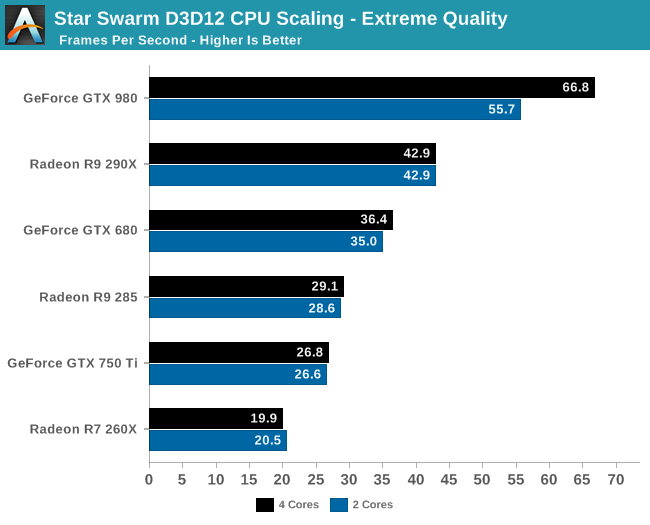
Having effectively ruled out the need for 6 core CPUs for Star Swarm, let’s take a look at a breakdown across all of our cards for performance with 2 and 4 cores. What we find is that Star Swarm and DirectX 12 are so efficient that only our most powerful card, the GTX 980, finds itself CPU-bound with just 2 cores. For the AMD cards and other NVIDIA cards we can get GPU bound with the equivalent of an Intel Core i3 processor, showcasing just how effective DirectX 12’s improved batch submission process can be. In fact it’s so efficient that Oxide is running both batch submission and a complete AI simulation over just 2 cores.
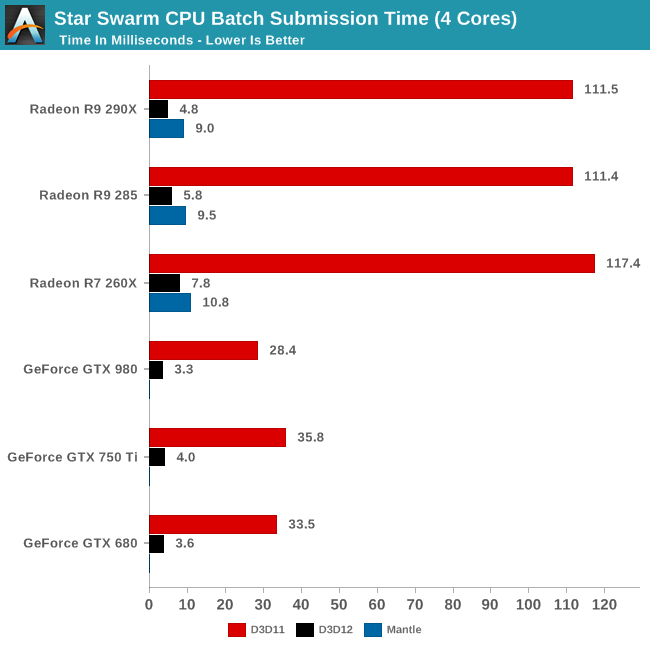
Speaking of batch submission, if we look at Star Swarm’s statistics we can find out just what’s going on with batch submission. The results are nothing short of incredible, particularly in the case of AMD. Batch submission time is down from dozens of milliseconds or more to just 3-5ms for our fastest cards, an improvement just overof a whole order of magnitude. For all practical purposes the need to spend CPU time to submit batches has been eliminated entirely, with upwards of 120K draw calls being submitted in a handful of milliseconds. It is this optimization that is at the core of Star Swarm’s DirectX 12 performance improvements, and going forward it could potentially benefit many other games as well.
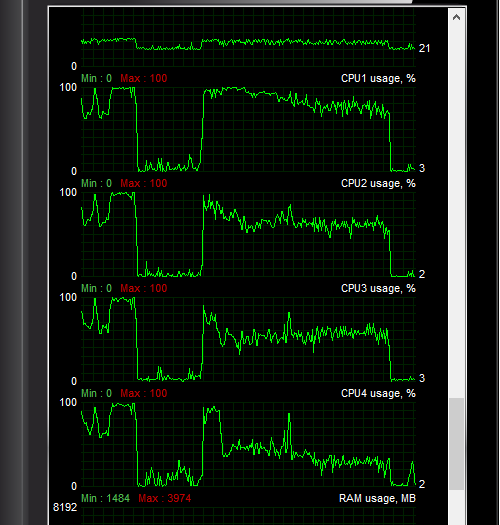
Another metric we can look at is actual CPU usage as reported by the OS, as shown above. In this case CPU usage more or less perfectly matches our earlier expectations: with DirectX 11 both the GTX 980 and R9 290X show very uneven usage with 1-2 cores doing the bulk of the work, whereas with DirectX 12 CPU usage is spread out evenly over all 4 CPU cores.
At the risk of speaking to the point that it’s redundant, what we’re seeing here is exactly why Mantle, DirectX 12, OpenGL Next, and other low-level APIs have been created. With single-threaded performance struggling to increase while GPUs continue to improve by leaps and bounds with each generation, something must be done to allow games to better spread out their rendering & submission workloads over multiple cores. The solution to that problem is to eliminate the abstraction and let the developers do it themselves through APIs like DirectX 12.










245 Comments
View All Comments
damianrobertjones - Saturday, February 7, 2015 - link
??? Eh? The computer, with DX12, is working harder AND offering better results.bitcrazed - Saturday, February 7, 2015 - link
Windows 7 will remain in broad use in businesses for a while yet, but given that Win10 will be a free upgrade for everyone else means that we should see far faster upgrades to Win10 than prior OS'.Put it this way - who here with a gaming rig or a machine they game on regularly is going to say - "No, I don't want a free upgrade to this new fangled Win10 + DX12 nonsense - I prefer to play my games at 10 fps and to gradually fade into obscurity"?
TheinsanegamerN - Sunday, February 8, 2015 - link
Gamers also seem to upgrade at a much faster rate. windows 8+8.1 make up 30% of steam windows users, while they only make up 12% of the general market. given that its FREE, windows 10 will probably become very popular very quickly.wolrah - Saturday, February 7, 2015 - link
Why would you say that? Windows 10 will be a free upgrade for anyone on a DX11 compatible system and so far has been a great OS to use. At the moment there's literally no reason not to upgrade.If Microsoft doesn't screw it up and the users aren't change-hating morons about it, Windows 7 and 8 should be fading memories in a year or two as far as the gaming community is concerned. Corporate users will still be themselves and be slower to upgrade, but corporate users' relevance to new gaming APIs is minimal.
aliquis - Monday, February 9, 2015 - link
Another stab at Valve and their SteamOS.OpenGL NG is quite a bit away and this will likely make Linux lag behind Windows in gaming again. For now.
Also with Xbox for Windows 10 I assume they may have some competition (which is likely why they wanted to migrate to Linux in the first place, because app-stores on any OS have become the standard.)
eanazag - Monday, February 9, 2015 - link
I'd like to see an integrated graphics version of this. Intel and AMD APU. If you're feeling fiesty, an AMD APU with a second card in Crossfire.Question I would have in an APU related article. With APUs, does it now make even more sense to go with higher bandwidth RAM? Some suggestions for the CPUs: AMD 7850K (duh), AMD A-6, AMD A-8, Haswell (Intel 7, 5, and 3 plus a crappy Pentium), AMD Kabini (top sku), and the Crystalwell Pro.
I think this has big mobile implications. I'd like to see a choice of a performance cap at 30-60 fps and the remainder of what's left on the table delivered in less heat and longer battery life.
SparkySamza - Tuesday, February 10, 2015 - link
what do you mean under windows 10; are you talking about windows 7 or even windows 8.1 ?tviceman - Friday, February 6, 2015 - link
Ryan I appreciate the depth and analysis of all your reviews. Anandtech is always my first stop for analysis of new video cards and tablets. That said, the continued tardiness of the GTX 960 review, as well as the lack of any 970 memory performance investigations is really disheartening. Especially the 960, since it's now 2 weeks today since the NDA was lifted.Keep up the analysis, and hire extra help if needed. ;)
Stuka87 - Friday, February 6, 2015 - link
Uhm, they had an article on the 970 memory issues:http://anandtech.com/show/8935/geforce-gtx-970-cor...
tviceman - Friday, February 6, 2015 - link
They did have an article, but they didn't do any extensive investigations into performance when going over 3.5gb but staying within 4gb.